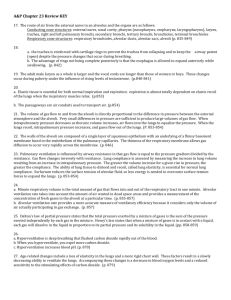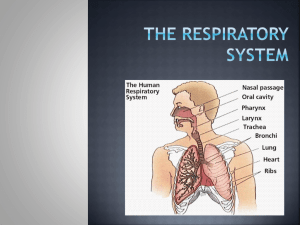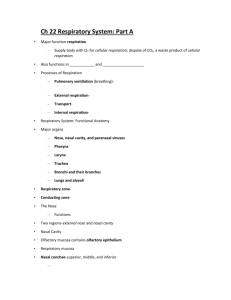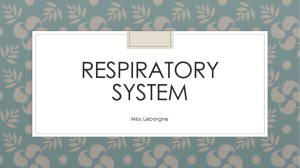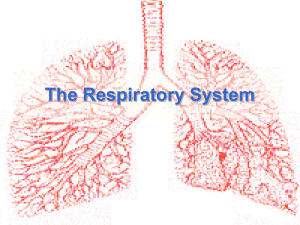Respiratory membrane
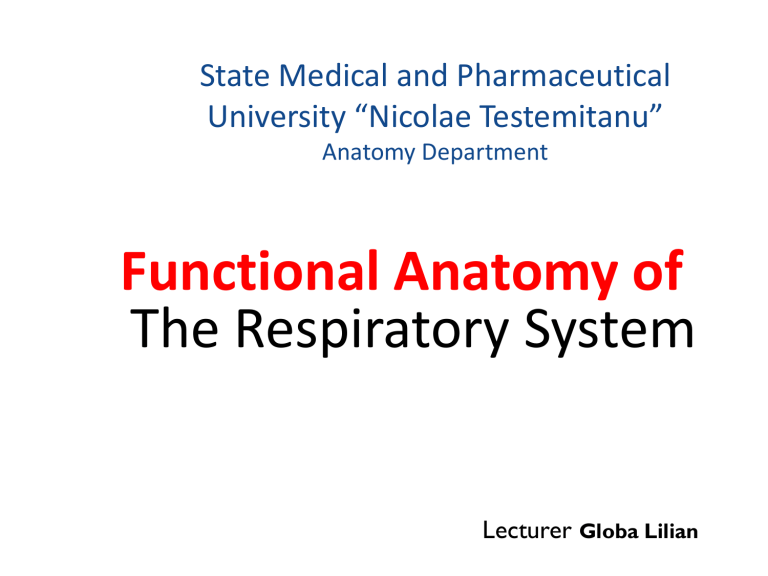
State Medical and Pharmaceutical
University “Nicolae Testemitanu”
Anatomy Department
Functional Anatomy of
The Respiratory System
Lecturer Globa Lilian
The
Respiratory
System
The Respiratory Organs
Conducting zone
– Respiratory passages that carry air to the site of gas exchange
– Filters, humidifies and warms air
Respiratory zone
– Site of gas exchange
– Composed of
• Respiratory bronchioles
• Alveolar ducts
• Alveolar sacs
Nose
• Provides airway
• Moistens and warms air
• Filters air
• Resonating chamber for speech
• Olfactory receptors
External nose
4
Nasal cavity
– Air passes through nares (nostrils)
– Nasal septum divides nasal cavity in midline (to right & left halves)
• Perpendicular plate of ethmoid bone, vomer and septal cartilage
– Connects with pharynx posteriorly through choanae (posterior nasal apertures*)
– Floor is formed by palate (roof of the mouth)
• Anterior hard palate and posterior soft palate
* palate
5
Linings of nasal cavity
• Vestibule* (just above nostrils)
– Lined with skin containing sebaceous and sweat glands and nose hairs
– Filters large particulars (insects, lint, etc.)
• The remainder of nasal cavity: 2 types of mucous membrane
– Small patch of olfactory mucosa near roof (cribriform plate)
– Respiratory mucosa: lines most of the cavity
Olfactory mucosa
*
Respiratory Mucosa
• Pseudostratified ciliated columnar epithelium
• Scattered goblet cells
• Underlying connective tissue lamina propria
– Mucous cells – secrete mucous
– Serous cells – secrete watery fluid with digestive enzymes, e.g. lysozyme
• Together all these produce a quart/day
– Dead junk is swallowed
7
*
*
Nasal Conchae
•Inferior to each is a meatus*
•Increases turbulence of air
•3 scroll-like structures
•Reclaims moisture on the way out
Of ethmoid
(its own bone)
*
8
9
Paranasal sinuses
– Frontal, sphenoid, ethmoid and maxillary bones
– Open into nasal cavity
– Lined by same mucosa as nasal cavity and perform same functions
– Also lighten the skull
– Can get infected: sinusitis
10
*
The Pharynx (throat)
• 3 parts: naso -, oro - and laryngo pharynx
• Houses tonsils (they respond to inhaled antigens)
• Uvula closes off nasopharynx during swallowing so food doesn’t go into nose
• Epiglottis posterior to the tongue: keeps food out of airway
• Oropharynx and laryngopharynx serve as common passageway for food and air
– Lined with stratified squamous epithelium for protection
*
11
The Larynx (voicebox)
• Extends from the level of the 4 th to the 6 th cervical vertebrae
• Attaches to hyoid bone superiorly
• Inferiorly is continuous with trachea (windpipe)
• Three functions:
1. Produces vocalizations (speech)
2. Provides an open airway (breathing)
3. Switching mechanism to route air and food into proper channels
• Closed during swallowing
• Open during breathing
12
• Framework of the larynx
– 9 cartilages connected by membranes and ligaments
– Thyroid cartilage with laryngeal prominence (Adam’s apple) anteriorly
– Cricoid cartilage inferior to thyroid cartilage: the only complete ring of cartilage: signet shaped and wide posteriorly
13
– Behind thyroid cartilage and above cricoid: 3 pairs of small cartilages
1. Arytenoid: anchor the vocal cords
2. Corniculate
3. Cuneiform
– 9 th cartilage: epiglottis
15
*
*
Epliglottis* (the 9 th cartilage)
Elastic cartilage covered by mucosa
On a stalk attached to thyroid cartilage
Attaches to back of tongue
During swallowing, larynx is pulled superiorly
Epiglottis tips inferiorly to cover and seal laryngeal inlet
Keeps food out of lower respiratory tract
Posterior views
16
• Cough reflex: keeps all but air out of airways
• Low position of larynx is required for speech
(although makes choking easier)
• Paired vocal ligaments: elastic fibers, the core of the true vocal cords
17
• Pair of mucosal vocal folds (true vocal cords) over the ligaments: white because avascular
18
• Glottis is the space between the vocal cords
• Laryngeal muscles control length and size of opening by moving arytenoid cartilages
• Sound is produced by the vibration of vocal cords as air is exhaled
19
Trachea (the windpipe)
• Descends: larynx through neck into mediastinum
• Divides in thorax into two main (primary) bronchi
• 16-20 C-shaped rings of hyaline cartilage joined by fibroelastic connective tissue
• Flexible for bending but stays open despite pressure changes during breathing
20
• Posterior open parts of tracheal cartilage abut esophagus
• Trachealis muscle can decrease diameter of trachea
– Esophagus can expand when food swallowed
– Food can be forcibly expelled
• Wall of trachea has layers common to many tubular organs – filters, warms and moistens incoming air
– Mucous membrane (pseudostratified epithelium with cilia and lamina propria with sheet of elastin)
– Submucosa ( with seromucous glands)
– Adventitia - connective tissue which contains the tracheal cartilages)
21
22
• Ridge on internal aspect of last tracheal cartilage
• Point where trachea branches
(when alive and standing is at
T7)
• Mucosa highly sensitive to irritants: cough reflex
Carina*
23
*
• Bronchial tree bifurcation
– Right main bronchus (more susceptible to aspiration)
– Left main bronchus
• Each main or primary bronchus runs into hilus of lung posterior to pulmonary vessels
1. Oblique fissure
2. Vertebral part
3. Hilum of lung
4. Cardiac impression
5. Diaphragmatic surface
(Wikipedia)
24
• Main=primary bronchi divide into secondary=lobar bronchi, each supplies one lobe
– 3 on the right
– 2 on the left
• Lobar bronchi branch into tertiary = segmental bronchi
• Continues dividing: about 23 times
• Tubes smaller than 1 mm called bronchioles
• Smallest, terminal bronchioles, are less the 0.5 mm diameter
• Tissue changes as becomes smaller
– Cartilage plates, not rings, then disappears
– Pseudostratified columnar to simple columnar to simple cuboidal without mucus or cilia
– Smooth muscle important: sympathetic relaxation
(“bronchodilation”), parasympathetic constriction
(“bronchoconstriction”)
25
Acinus
• End-point of respiratory tree
• Structures that contain air-exchange chambers are called alveoli
• Respiratory bronchioles lead into alveolar ducts: walls consist of alveoli
• Ducts lead into terminal clusters called alveolar sacs – are microscopic chambers
• There are 3 million alveoli!
26
Gas Exchange
• Air filled alveoli account for most of the lung volume
• Very great area for gas exchange (1500 sq ft)
• Alveolar wall
– Single layer of squamous epithelial cells (type 1 cells) surrounded by basal lamina
– 0.5um (15 X thinner than tissue paper)
– External wall covered by cobweb of capillaries
• Respiratory membrane: fusion of the basal laminas of
– Alveolar wall
– Capillary wall Respiratory bronchiole
Alveolar duct
(air on one side; blood on the other)
Alveoli
Alveolar sac
27
• This “air-blood barrier” (the respiratory membrane) is where gas exchange occurs
– Oxygen diffuses from air in alveolus (singular of alveoli) to blood in capillary
– Carbon dioxide diffuses from the blood in the capillary into the air in the alveolus
28
Surfactant
• Type II cuboidal epithelial cells are scattered in alveolar walls
• Surfactant is a detergent-like substance which is secreted in fluid coating alveolar surfaces – it decreases tension
• Without it the walls would stick together during exhalation
• Premature babies – problem breathing is largely because lack surfactant
29
Microscopic detail of alveoli
• Alveoli surrounded by fine elastic fibers
• Alveoli interconnect via alveolar pores
• Alveolar macrophages – free floating “dust cells”
• Note type I and type II cells and joint membrane
30
31
Lungs and Pleura
Around each lung is a flattened sac of serous membrane called pleura
Parietal pleura – outer layer
Visceral pleura – directly on lung
Pleural cavity – slit-like potential space filled with pleural fluid
• Lungs can slide but separation from pleura is resisted (like film between 2 plates of glass)
• Lungs cling to thoracic wall and are forced to expand and recoil as volume of thoracic cavity changes during breathing
32
CXR
(chest x-ray)
33
Chest x rays
Normal female Lateral (male)
34
• Pleura also divides thoracic cavity in three
– 2 pleural, 1 pericardial
• Pathology
– Pleuritis
– Pleural effusion
35
Relationship of organs in thoracic cavity
36
• Paired lungs occupy all thoracic cavity lateral to the mediastinum
• Mediastinum contains (mainly): heart, great blood vessels, trachea, main bronchi, esophagus
37
Lungs
• Each is cone-shaped with anterior, lateral and posterior surfaces contacting ribs
• Superior tip is apex, just deep to clavicle
• Concave inferior surface resting on diaphragm is the base apex apex base base
38
• Hilus or (hilum)
– Indentation on mediastinal (medial) surface
– Place where blood vessels, bronchi, lymph vessel, and nerves enter and exit the lung
• “Root” of the lung
– Above structures attaching lung to mediastinum
– Main ones: pulmonary artery and veins and main bronchus
Medial view R lung Medial view of L lung
39
• Right lung: 3 lobes
– Upper lobe
– Middle lobe
Oblique fissure
– Lower lobe
Horizontal fissure
• Left lung: 2 lobes
– Upper lobe
– Lower lobe
Oblique fissure
Each lobe is served by a lobar (secondary) bronchus
Abbreviations in medicine: e.g.” RLL pneumonia”
40
• Each lobe is made up of bronchopulmonary segments separated by dense connective tissue
– Each segment receives air from an individual segmental
(tertiary) bronchus
– Approximately 10 bronchopulmonary segments in each lung
– Limit spread of infection
– Can be removed more easily because only small vessels span segments
• Smallest subdivision seen with the naked eye is the lobule
– Hexagonal on surface, size of pencil eraser
– Served by large bronchiole and its branches
– Black carbon is visible on connective tissue separating individual lobules in smokers and city dwellers
41
• Pulmonary arteries bring oxygen-poor blood to the lungs for oxygenation
– They branch along with the bronchial tree
– The smallest feed into the pulmonary capillary network around the alveoli
• Pulmonary veins carry oxygenated blood from the alveoli of the lungs to the heart
42
• Stroma – framework of connective tissue holding the air tubes and spaces
– Many elastic fibers
– Lungs light, spongy and elastic
– Elasticity reduces the effort of breathing
• Blood supply
– Lungs get their own blood supply from bronchial arteries and veins
• Innervation: pulmonary plexus on lung root contains sympathetic, parasympathetic and visceral sensory fibers to each lung
– From there, they lie on bronchial tubes and blood vessels within the lungs
43
Together:
Muscles of Inspiration
• During inspiration, the dome shaped diaphragm flattens as it contracts
– This increases the height of the thoracic cavity
• The external intercostal
muscles contract to raise the ribs
– This increases the circumference of the thoracic cavity
44
Expiration
• Quiet expiration in healthy people is chiefly passive
– Inspiratory muscles relax
– Rib cage drops under force of gravity
– Relaxing diaphragm moves superiorly (up)
– Elastic fibers in lung recoil
– Volumes of thorax and lungs decrease simultaneously, increasing the pressure
– Air is forced out
45
Expiration continued
• Forced expiration is active
– Contraction of abdominal wall muscles
• Oblique and transversus predominantly
– Increases intra-abdominal pressure forcing the diaphragm superiorly
– Depressing the rib cage, decreases thoracic volume
• Some help from internal intercostals and latissimus dorsi
(try this on yourself to feel the different muscles acting)
46
Pneumothorax
47
• There are many diseases of the respiratory system, including asthma, cystic fibrosis, COPD (chronic obstructive pulmonary disease – with chronic bronchitis and/or emphysema) and epiglottitis example: normal emphysema
48
you might want to think twice about smoking….
49

